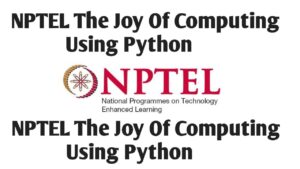Nptel The Joy of Computing Using Python Week 9 Assignment Answers
Searching for the Week 9 answers of the Nptel The Joy of Computing Using Python course? You’re in the right spot! Here, you’ll find reliable and up-to-date solutions to help you complete your Week 9 assignment with confidence.

The Joy of Computing using Python
ABOUT THE COURSE :
INTENDED AUDIENCE : Any interested audience
PREREQUISITES : 10th standard/high school
INDUSTRY SUPPORT : Every software company is aware of the potential of a first course in computer science. Especially of a first course in computing, done right.
COURSE LAYOUT – Click To Know More
- Motivation for Computing
- Welcome to Programming!!
- Variables and Expressions : Design your own calculator
- Loops and Conditionals : Hopscotch once again
- Lists, Tuples and Conditionals : Lets go on a trip
- Abstraction Everywhere : Apps in your phone
- Counting Candies : Crowd to the rescue
- Birthday Paradox : Find your twin
- Google Translate : Speak in any Language
- Currency Converter : Count your foreign trip expenses
- Monte Hall : 3 doors and a twist
- Sorting : Arrange the books
- Searching : Find in seconds
- Substitution Cipher : What’s the secret !!
- Sentiment Analysis : Analyse your Facebook data
- 20 questions game : I can read your mind
- Permutations : Jumbled Words
- Spot the similarities : Dobble game
- Count the words : Hundreds, Thousands or Millions.
- Rock, Paper and Scissor : Cheating not allowed !!
- Lie detector : No lies, only TRUTH
- Calculation of the Area : Don’t measure.
- Six degrees of separation : Meet your favourites
- Image Processing : Fun with images
- Tic tac toe : Let’s play
- Snakes and Ladders : Down the memory lane.
- Recursion : Tower of Hanoi
- Page Rank : How Google Works !!
Nptel The Joy of Computing Using Python Week 9 Assignment Answers
1. How can we identify which book is written by which author?
a. By matching handwriting
b. By analyzing word length with previous books
c. By analyzing the number of pages in a book
d. By analyzing the book’s preface
View Answer
2. What is the key difference between lists and tuples in Python, and when would you choose one over the other?
a. Lists are immutable and can be used when elements need to be modified, while tuples are mutable and best for storing fixed data.
b. Lists are mutable and can be used for dynamic data manipulation, while tuples are immutable and used to store fixed collections of items.
c. Both lists and tuples are mutable and can be used interchangeably for any purpose.
d. Tuples are used only for string data, while lists can store any data type.
View Answer
3. Will the following piece of code always return True?
a. True
b. False
View Answer
4. What is the output of the following code?
a. ?
b. ?
c. ?
d. ?
View Answer
For Latest Update Join our official channel: Click here to join
5. What is the total degree of the given graph?
a. 10
b. 8
c. 6
d. 4
View Answer
6. Which of the following is always true for a connected undirected graph with at least one edge?
a. Every node has an even degree
b. The sum of all node degrees is even
c. The graph contains an Eulerian path
d. The graph contains a Hamiltonian cycle
View Answer
7. What is the primary difference between using single quotes, double quotes, and triple quotes to create strings in Python?
a. Single and double quotes can only be used for single-line strings, while triple quotes are used for multi-line strings
b. Single quotes are used for strings with one word, while double quotes are for strings with multiple words
c. Double quotes are more efficient than single quotes for creating strings
d. There is no difference in how Python interprets single quotes, double quotes, or triple quotes for strings
View Answer
8. How many nodes and edges does the following graph have?
a. 10,6
b. 10,5
c. 8,6
d. 8,5
View Answer
For Latest Update Join our official channel: Click here to join
9. A complete graph will have a degree of separation?
a. 1
b. 2
c. 3
d. Depends on the number of nodes
View Answer
10. What will be the output of the following code?
a. It will print “Hello”
b. It will raise a TypeError
c. The string will be updated to “Hello”
d. It will change the first character to uppercase and print “Hello”
View Answer
Nptel The Joy Of Computing Using Python Week 10 Assignment Answers – Click Here